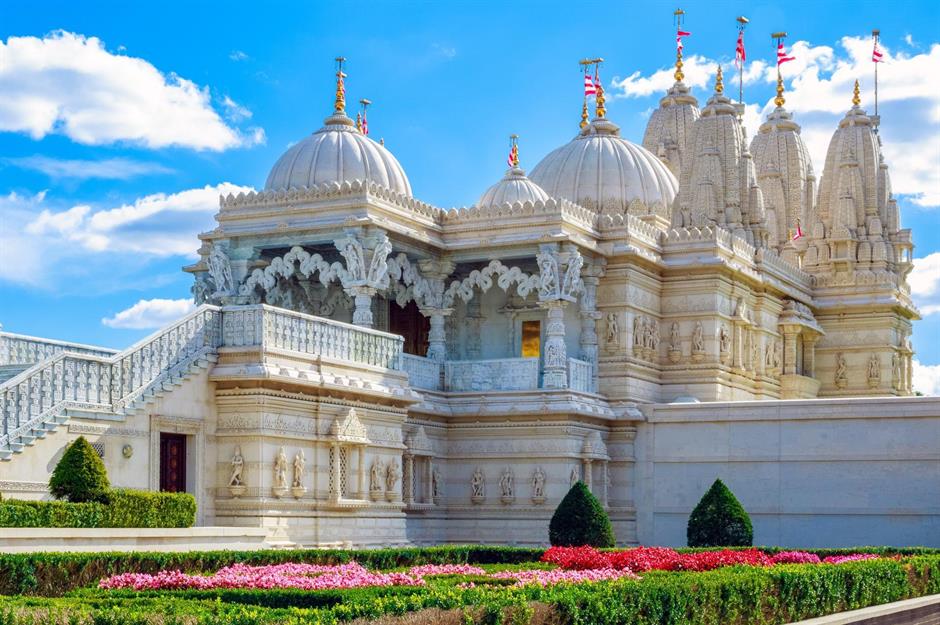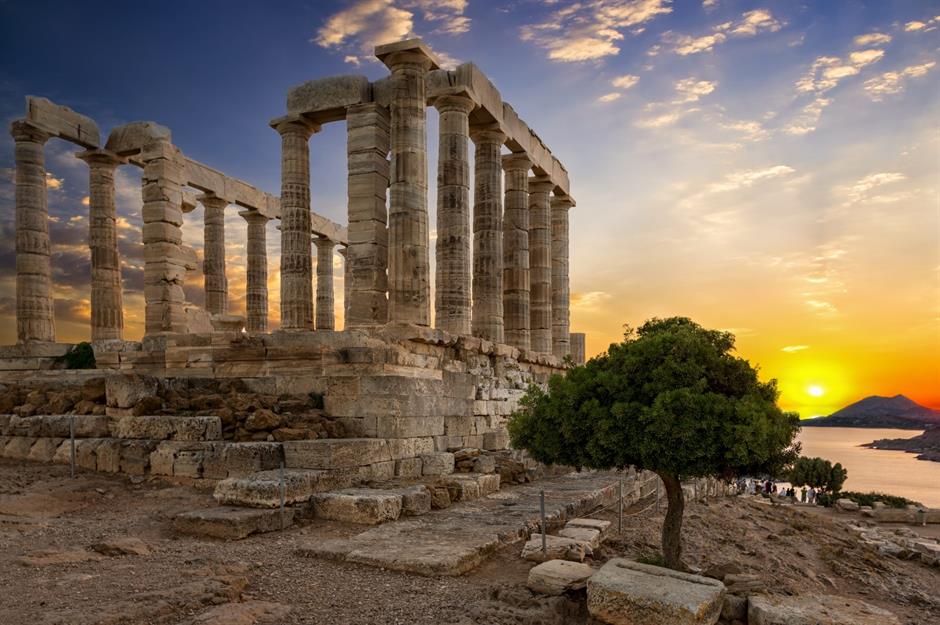World’s most beautiful temples
Stunning sacred sights
A place for worship, spirituality and sacrifice, temples have been built by religions around the world to celebrate gods and deities since ancient times. From floating shrines and striking synagogues to golden monuments and sprawling sacrificial sites, we take a look at the stories behind these incredible buildings with the help of Michael Kerrigan's new book Amazing Temples of the World.
Temple of Poseidon, Cape Sounion, Greece
Perched on the rocky outcrop of Cape Sounion in southern Greece, this ancient temple serves as a testament to the Golden Age of Athens. The Temple of Poseidon was built between 444–40 BC dedicated to the god of the sea and was believed to be part of a building project initiated by Athenian statesman Pericles (493–29 BC) which also included the Parthenon and the Hephaisteion. With its strategic hilltop position, the temple also guarded the shipping lanes that connected Athens with the rest of the world. Beautifully preserved, the temple has even drawn many visitors including renowned 19th-century English poet Lord Byron, whose graffiti can be seen on its ruins.
Wat Xieng Thong, Laos
Situated in northern Laos, Wat Xieng Thong is one of the most important temples in the country. The temple was built in the mid-16th century by King Setthathirath in memory of the legendary King Chanthaphanith. With its gorgeous, gilded roof, ornate gold stencilling and stunning sculptures, Wat Xieng Thong is often regarded as one of the most beautiful temples in Laos. This image shows one of the temple’s colourful mosaic-patterned walls, depicting a bustling scene with trees, animals, growing crops, priests praying and sailing boats.
Trán Quóc Pagoda, Hanoi, Vietnam
Situated on a small island in Hanoi’s West Lake, the Trán Quóc Pagoda has a history of more than 1,500 years. Although a Buddhist temple has been here since the 6th century, the current structures date back to the 17th century. A Bodhi tree, which can be found on the grounds, was grown from a cutting from the original tree, gifted by the Indian president on a visit to Hanoi in 1959.
Eldridge Street Synagogue, New York, USA
The Eldridge Street Synagogue is just a few of the remaining 19th-century buildings that remain relatively unchanged in the heart of New York City. Built in 1887 by Eastern European Jews, the synagogue was one of the first buildings of its kind and became a sanctuary for Jewish immigrants in the Lower East Side before its decline in the late 1920s. Following a restoration project in the early 20th century, the Eldridge Street Synagogue continues to be used as a place of worship as well as a museum exploring its history.
Jubilee Synagogue, Prague, Czech Republic
With its colourful and striking façade in the middle of Prague’s famous domes and spires, the Jubilee Synagogue is a beautiful sight. Completed in 1906, the synagogue was built to replace church buildings that were demolished due to sanitation, and it is the newest of its kind in the city. Constructed in Art Nouveau and pseudo-Moorish styles, the Jubilee Synagogue was based on the plans of Vienna architect and synagogue builder Wilhelm Stiassny in honour of the Silver Jubilee of Emperor Franz Joseph I of Austria. Inside, its bold interior is richly decorated with a rainbow of colours and lavish details, making it the most spectacular synagogue in Prague.
Parthenon, Athens, Greece
A true symbol of Ancient Greek design, the Parthenon in Athens is one of the most recognisable temples in the world. It was built in the mid-5th century BC in honour of Athena, the Greek goddess of war, women’s handicrafts and wisdom. The Parthenon stands proudly as the sparkling centrepiece of the Acropolis of Athens, a complex of ancient structures on a rocky outcrop overlooking the city.
The Golden Temple, Amritsar, India
Lying in the Indian city of Amritsar, this glittering shrine gets its name from its lavish gilded exterior. Constructed between the 16th and 17th centuries, the Golden Temple was built to create a central place of worship for Sikhs. The temple has a tumultuous history, it was destroyed several times by Afghan invaders until it was finally rebuilt in the early 19th century with marble and copper overlaid with gold foil. It then became the Golden Temple.
Shri Swaminarayan Mandir, Toronto, Canada
This grand temple in Toronto, Canada opened in 2007, over 10 years after its sister shrine in London. With the help of over 1,800 craftsmen who were mostly volunteers from the BAPS, a Hindu organisation, it took over 24,000 pieces of hand-carved stone to build the temple and roughly 18 months to complete. The Shri Swaminarayan Mandir has provided a place of sanctuary and worship for the Indian immigrant community of Toronto.
Wat Phra That Doi Suthep, Chiang Mai Province, Thailand
Nestled on a mountain overlooking the city of Chiang Mai, this gold temple is one of the most sacred pilgrimage spots in northern Thailand. Legend has it that a monk from Sukhothai discovered a relic (bone) from the Buddha himself and took it to King Ramkamhaeng. The king was unconvinced that it was real, so it was transported across the country to King Kue Na of Lanna Kingdom. Before the relic could be enshrined it broke into two and the king placed a piece onto the back of a white elephant. The elephant climbed up the slopes of Doi Suthep, trumpeted twice then dropped dead. The temple seen today was built in the 14th century where the animal is believed to have died.
Temple of Zeus, Aizanoi, Turkey
Often hailed as one of the best-preserved Roman temples in the world, the Temple of Zeus can be found in the Phrygian city of Aizanoi in what is now western Turkey. Completed in the 2nd century AD, the temple’s most impressive feature is its womb-like underground chamber, pictured here. The chamber is believed to have been used as a place of worship and for ritual offerings to the ancient goddess Cybele, who was the Great Mother of the Gods.
Bodh Gaya, Bihar, India
Home to one of the holiest Buddhist sites in the world, Bodh Gaya lies in northeast India’s Bihar state. As the story goes, Gautama Siddhartha (Buddha) travelled here to seek the truth then sat beneath a Bodhi tree to rest and meditate. A few nights later he stood up and continued his journey, having obtained enlightenment. The Mahabodhi Temple was constructed here to mark this sacred site and revelation. With its religious and philosophical significance, the Bodh Gaya complex earned UNESCO World Heritage status in 2002.
Temple of Debod, Madrid, Spain
Dating back to the 2nd century BC, this magnificent structure in Spain was originally located in Egypt. Following the construction of the Aswan High Dam in the 1960s, the Egyptian government gave the Temple of Debod as a gift to the city of Madrid to save it from flood damage. The temple was transported and rebuilt in the city's Parque de la Montaña before it opened to the public in 1972.
Boudhanath, Kathmandu, Nepal
Dominating Kathmandu’s northeastern district in Nepal, this spectacular stupa stretches around 118 feet (36m) tall. Boudhanath serves as a symbolic reminder of Buddha’s path towards enlightenment. The base represents the Earth, its sloping dome is the water, the square tower is fire and the pointed tip is the air. Supas were originally built to house holy relics with some claiming that Bouddharth contains relics such as a piece of bone from Siddhartha Gautama, the historical Buddha. Boudhanath has been a UNESCO World Heritage Site since 1979 and has become one of the most popular tourist destinations in the state.
Temple of Heaven, Beijing, China
The most complete sacrificial building complex in China, the Temple of Heaven is a prime example of traditional Chinese architecture. Situated in the old city outskirts of Beijing, the religious site was a focal point of prayer and sacrifice to the God of Heaven by emperors in the hope of securing successful harvests. Inside, the Temple of Heaven is home to around 92 ancient buildings and 600 rooms, making it the largest existing building complex for offering sacrifice to Heaven on the planet.
Japanese Peace Pagoda, Unawatuna, Sri Lanka
Virupaksha Temple, Hampi, India
Krishna Temple, Durban, South Africa
Just south of Durban’s city centre is this dazzling Hindu temple in Chatsworth. Designed and built in the 1980s, the Krishna Temple combines traditional, contemporary and futuristic styles and is often hailed as an architectural masterpiece. With its elaborate decorations including marble tiles from Portugal and oak wood from Japan, surrounded by a sprawling lotus-shaped garden, the temple is often regarded as one of the most beautiful on the continent of Africa.
Itsukushima Shrine, Hatsukaichi, Japan
On an island in Hiroshima Bay in Japan, this mythical shrine looks as if it’s floating on water. Dating back centuries, the Shinto temple was built as a holy place for Shintoism, which is a Japanese devotion to spiritual beings and powers called kami. Itsukushima Shrine is best known for its Torri gate, which signifies the entrance to the sacred precincts of the shrine which, at low tide, seems to magically float on the sea. The shrine was founded in the 12th century by the powerful military leader Taira no Kiyomori. With its mythical appearance, the shrine has become a popular tourist hot spot.
Shri Swaminarayan Mandir, London, England
With its grand appearance resembling a temple you may come across in India, it’s hard to believe that Shri Swaminarayan Mandir is actually a hidden gem in London. Inaugurated in 1995, the temple was built using over 5,000 tonnes of Italian Carrara and Indian marble, plus Bulgarian limestone which was hand-carved in India before it was shipped to England’s capital where it was assembled. Also known as Neasden Temple, it was the first Hindu stone temple in Europe.
Here are more stunning photos of places you won’t believe are in the UK
Find out more
All images are taken with permission from the book Amazing Temples of the World by Michael Kerrigan, published by Amber Books Ltd and available via Amazon.

